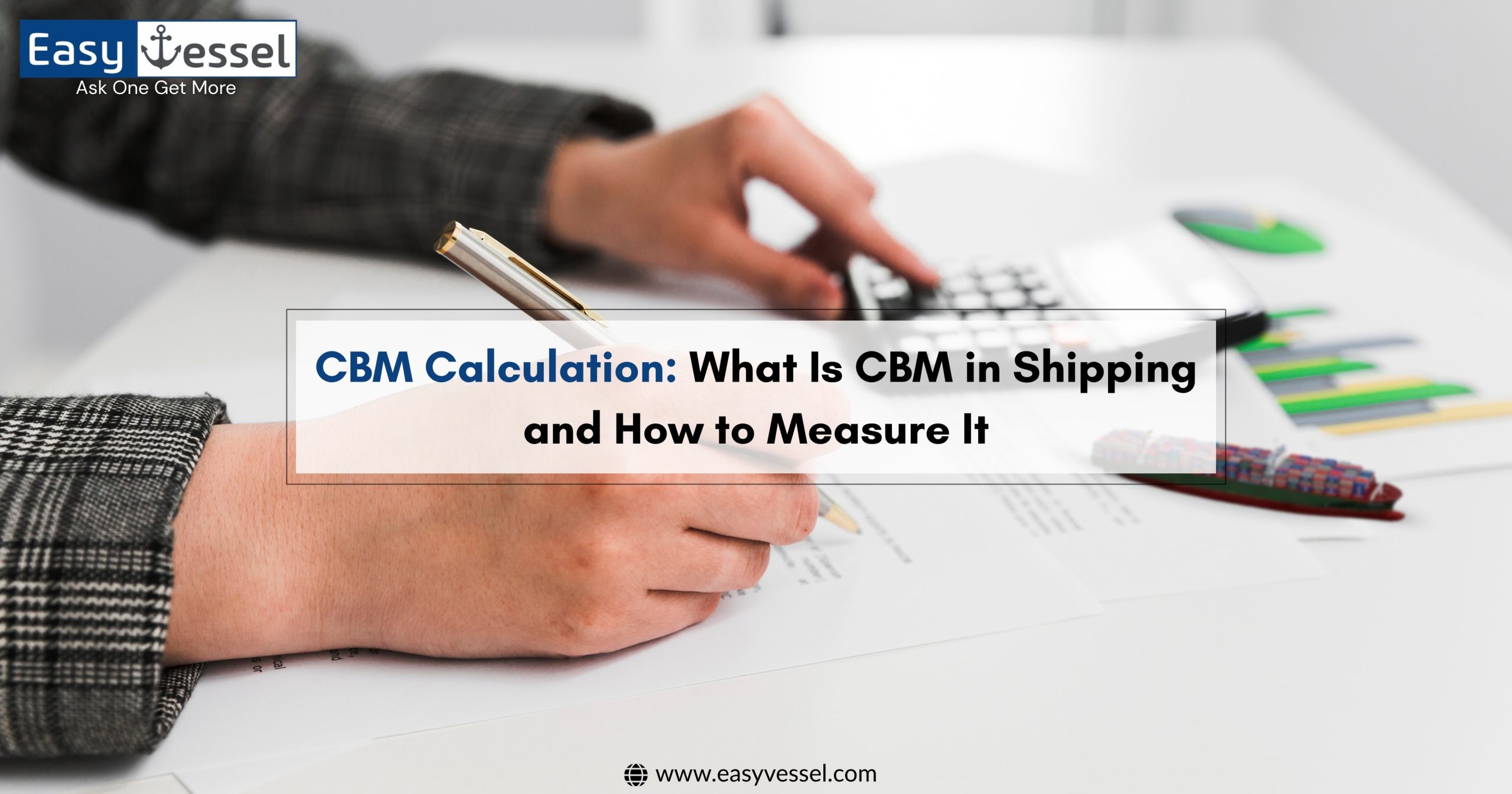One of the most critical measurements to understand is CBM when dealing with global trade and logistics. For Cubic Meters, CBM determines shipping costs, container space, and freight efficiency. Whether you’re a business owner, freight forwarder, or just diving into international logistics, having a clear grasp of CBM in shipping is essential.
In this blog, we’ll break down what CBM is, why it matters in logistics, and exactly how to calculate CBM for different types of shipments. We’ll also share how a trusted logistics service provider like Easyvessel can streamline your shipping operations.
What Is CBM in Shipping?
CBM, or Cubic Meter, is a unit of volume used to measure how much space a shipment occupies. In logistics services, particularly sea freight, CBM helps estimate the space of your cargo in a container.
1 CBM equals a space measuring 1 meter wide, 1 meter long, and 1 meter high.
This simple unit becomes the basis for calculating cargo space, determining freight rates, and choosing appropriate containers.
For instance, if you’re shipping a batch of cartons internationally, calculating the CBM tells you how many can fit in a 20-foot or 40-foot container. This makes CBM calculation a critical part of freight planning and budgeting.
Why Is CBM Important in Logistics?
Understanding CBM is essential for anyone involved in logistics services. Here’s why:
- Accurate Freight Cost Estimation: Freight charges for sea, air, or land shipments are often based on volume (CBM) or weight, whichever is greater.
- Container Optimization: Knowing your cargo’s volume ensures you use the right container size without overpaying for unused space.
- Efficient Loading Plans: Freight forwarders use CBM data to plan how to load cargo to maximize efficiency and reduce damage.
Whether a small exporter or a large-scale manufacturer, mastering CBM helps you save costs and avoid logistics headaches.
CBM Calculation Formula
The formula for CBM is quite simple:
CBM = Length (m) × Width (m) × Height (m)
Ensure all dimensions are in meters before multiplying. If your measurements are in centimeters or inches, convert them first:
- Centimeters to meters: divide by 100
- Inches to meters: multiply by 0.0254
Let’s look at a quick example:
- Length = 100 cm (1 meter)
- Width = 80 cm (0.8 meter)
- Height = 120 cm (1.2 meter)
CBM = 1 × 0.8 × 1.2 = 0.96 CBM
How to Calculate CBM for Sea Shipment
Calculating CBM for sea shipment involves a few extra considerations. Since sea freight often deals with bulk cargo or multiple packages, you need to calculate the CBM for each package and then total them up.
Here’s a step-by-step process:
Step 1: Measure Each Package
Measure the length, width, and height of each item in meters. If items are in cartons or pallets, measure the whole unit.
Step 2: Multiply to Get CBM per Package
Use the basic CBM formula for each package.
Step 3: Multiply by Quantity
If you have multiple identical packages, multiply the CBM by the number of units.
Step 4: Add It All Together
Sum the CBMs of each item to get the total CBM for your sea shipment.
Example:
You have 10 cartons, each measuring:
- Length = 0.5 m
- Width = 0.4 m
- Height = 0.6 m
CBM per carton = 0.5 × 0.4 × 0.6 = 0.12
Total CBM = 0.12 × 10 = 1.2 CBM
How to Calculate CBM for Air Shipment
Calculating CBM for air shipment follows the same basic principle as for sea freight: measuring the volume of your cargo. However, the difference lies in how air carriers determine chargeable weight, directly impacting freight costs.
Step 1: Measure Your Package Dimensions
Start by measuring each package’s length, width, and height in centimeters (cm), as air freight commonly uses this unit.
Step 2: Calculate the Volume in CBM
Convert the dimensions into meters and use the CBM formula:
CBM = Length (m) × Width (m) × Height (m)
Or, if you’re keeping the dimensions in centimeters:
CBM (m³) = (L × W × H in cm) ÷ 1,000,000
Step 3: Convert CBM to Volumetric Weight
Air freight is usually billed based on volumetric weight, which is calculated using the following formula:
Volumetric Weight (kg) = (L × W × H in cm) ÷ 6000
Compare this volumetric weight with the actual weight of your package. The higher value is what the airline uses to charge you.
Example:
- Dimensions: 100 cm × 60 cm × 50 cm
- Actual weight: 40 kg
- Volumetric weight = (100 × 60 × 50) ÷ 6000 = 50 kg
In this case, you’ll be billed for 50 kg, not 40 kg.
CBM for Different Shapes and Cargo Types
Most cargo comes in boxes or pallets, but sometimes items may be cylindrical, irregularly shaped, or shrink-wrapped. Here’s how to handle different types:
1. Palletized Goods
For palletized cargo, measure the entire pallet, including the height of the pallet itself.
2. Cylindrical Cargo
Use the formula:
CBM = π × (radius²) × height
Make sure the radius and height are in meters. This is common for barrels or rolls.
3. Irregular-Shaped Items
Use the smallest rectangular box containing the item to estimate CBM for irregular items.
Weight vs. Volume: When Does CBM Matter Most?
In international shipping, you often hear about chargeable weight. Freight carriers charge based on the following:
- Gross weight (actual weight)
- Volumetric weight (CBM)
Carriers usually charge by CBM for sea freight unless the cargo is hefty. For air freight, charges are based on whichever is greater—actual or volumetric weight.
This is why CBM calculation is so critical. A light but bulky item might cost more than a dense, heavier one due to the space it occupies.
Tools to Help with CBM Calculation
While the formula is simple, managing large orders with various package sizes can get complicated. Here are some tools logistics professionals use:
- Excel spreadsheets with CBM formulas
- Online CBM calculators
- Logistics software platforms with auto-calculation features
Many logistics service providers offer assistance with CBM estimates during the quotation process.
Working with a Freight Forwarder for Accurate CBM Planning
Freight forwarders are experts in managing shipments from origin to destination. They understand how to calculate CBM, plan container loads, and reduce costs.
Here’s how a freight forwarder adds value:
- Verifies your cargo volume and weight
- Recommends optimal container types
- Helps consolidate shipments efficiently
- Prevents overpaying for space or delays due to poor planning
Partnering with a trusted logistics service provider for businesses dealing with frequent international shipments can lead to significant savings and smoother operations.
Common Mistakes to Avoid When Calculating CBM
Even though it’s simple, CBM calculation can go wrong due to:
- Incorrect unit conversions (e.g., using cm instead of meters)
- Ignoring pallet height or packaging material
- Forgetting to multiply by quantity
- Estimating instead of measuring
Double-check all measurements and conversions, and if in doubt, consult your freight forwarder.
Read More: 5 Common International Shipping Mistakes and How to Avoid Them
CBM Guidelines for Standard Shipping Containers
To put CBM into context, here are the maximum capacities of standard sea containers:
- 20-foot container: ~33 CBM
- 40-foot container: ~67 CBM
- 40-foot high cube: ~76 CBM
Your usable volume may be slightly lower due to packaging and weight distribution, but this gives a rough idea of how much cargo you can fit based on your CBM calculation.
Conclusion: Get Expert Help with Your CBM and Shipping Needs
Whether shipping a few cartons or full containers, understanding CBM is key to keeping costs low and operations smooth. From calculating volume accurately to optimizing cargo space, it starts with knowing how to measure your goods.
If you’re looking for a reliable freight forwarder to assist with CBM planning, container booking, and overall shipping logistics, look no further than Easyvessel.
Why Choose Easyvessel?
- Accurate and transparent CBM calculation
- Expert handling of sea, air, and land freight
- End-to-end support from pickup to delivery
- Personalized service tailored to your business needs
Trust Easyvessel as your go-to logistics service provider to simplify shipping and ensure your cargo moves efficiently—every time.
Reference:
CBM (Cubic meter) by Wikipedia[1].
Frequently Asked Questions
Multiply the length × width × height of the package (in meters):
CBM = L × W × H
A standard 20-foot container holds up to 33 CBM, but usable space is around 28–30 CBM, depending on packing.
CBM and kg measure different things. For air freight, 1 CBM ≈ 167 kg (volumetric weight). There’s no fixed CBM per kg—it depends on cargo density.
If your package dimensions are in inches:
CBM = (Length × Width × Height in inches) × 0.000016387064
Example:
A box that is 40 in × 30 in × 20 in:
CBM = (40 × 30 × 20) × 0.000016387064 = 0.3933 CBM
To convert CBM to volumetric weight in air freight:
Volumetric Weight (kg) = CBM × 167
This helps determine whether weight or volume affects the shipping rate more.



